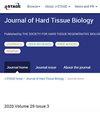种植体周围炎与氟化物的相关性研究
IF 0.4
4区 医学
Q4 ENGINEERING, BIOMEDICAL
引用次数: 0
摘要
氟化物最近被认为是种植体周围炎的一个危险因素。然而,没有报告证实在人类或大型动物实验中口服这种药物。因此,在本研究中,我们使用beagle来验证种植体种植和诱导种植体周围炎对周围组织的影响。为了阐明与种植体周围炎的任何可能的相关性,我们还定量检查了氟化物引起的钛腐蚀和洗脱。受试者分为三组,即(1)不加氟,不加压螺纹;(2)加氟,无压力螺纹;(3)氟化,压力螺纹。12个种植体全部成活,种植体成活率为100%。口腔x线测量骨吸收和μCT测量骨破坏体积显示(3)组骨吸收和骨破坏明显高于(1)组,(1)组与(2)组间差异无统计学意义,(2)组与(3)组间差异无统计学意义。扫描电镜测量种植体周围牙龈钛含量,三组间差异无统计学意义。基于定量数据,我们的结果表明氟化物加剧了种植体周围炎。本文章由计算机程序翻译,如有差异,请以英文原文为准。
Elucidation of the Relationship between Peri-Implantitis and Fluoride: A Correlation Study
Fluoride has recently been indicated as a risk factor for peri-implantitis. However, no reports have confirmed this intraorally in humans or in experiments using large animals. Thus, in the present study, we used beagles to verify the effects on surrounding tissue when dental implants were implanted and peri-implantitis was induced. To elucidate any possible correlation with peri-implantitis, we also quantitatively examined titanium corrosion and elution due to fluoride. subjects were divided into three groups, namely, (1) no fluoride, no pressure thread; (2) fluoride, no pressure thread; and (3) fluoride, pressure thread. All the total 12 implants survived, indicating an implant survival rate of 100%. Dental X-ray measurement of bone resorption and measurement of bone destruction volume with μCT indicated significantly more bone resorption and bone destruction in group (3) than in group (1). There was no significant difference between group (1) and group (2). in addition, there was no significant difference between group (2) and group (3). Scanning electron microscope measurement of titanium in gingiva around the implants did not reveal any significant differences among the three groups. Based on quantitative data, our results suggested that fluoride exacerbates peri-implantitis.
求助全文
通过发布文献求助,成功后即可免费获取论文全文。
去求助
来源期刊

Journal of Hard Tissue Biology
ENGINEERING, BIOMEDICAL-
CiteScore
0.90
自引率
0.00%
发文量
28
审稿时长
6-12 weeks
期刊介绍:
Information not localized
 求助内容:
求助内容: 应助结果提醒方式:
应助结果提醒方式:


